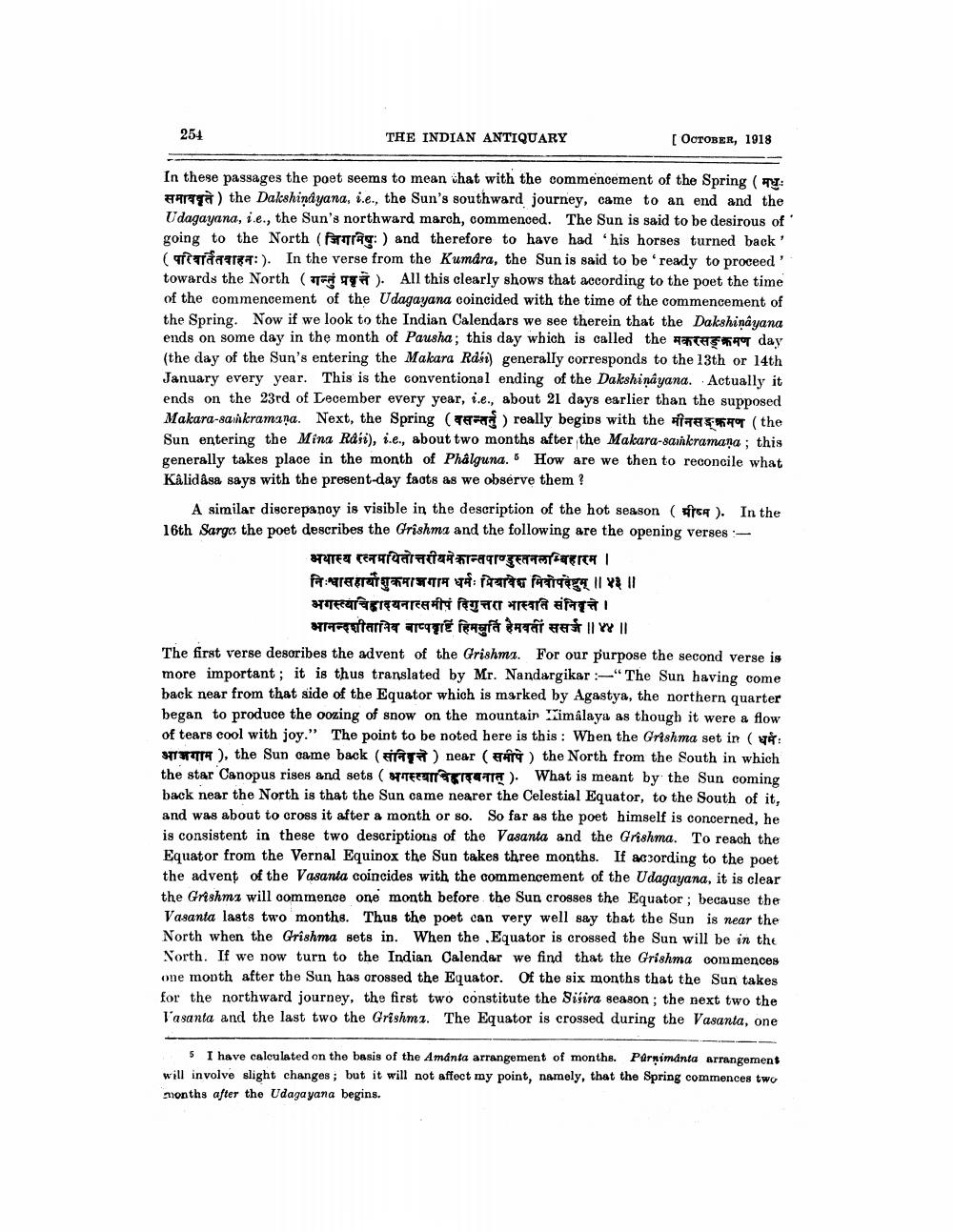________________
254
THE INDIAN ANTIQUARY
[OCTOBER, 1918
In these passages the poet seems to mean chat with the commencement of the Spring ( :
Ar ) the Dakshindyana, i.e., the Sun's southward journey, came to an end and the Udagayana, i.e., the Sun's northward march, commenced. The Sun is said to be desirous of going to the North ( Tag:) and therefore to have had his horses turned back' (Targa:). In the verse from the Kumara, the Sun is said to be ready to proceed' towards the North ( T TY ). All this clearly shows that according to the poet the time of the commencement of the Udagayana coincided with the time of the commencement of the Spring. Now if we look to the Indian Calendars we see therein that the Dakshinayana ends on some day in the month of Pausha; this day which is called the fanta*47 day (the day of the Sun's entering the Makara Rasi) generally corresponds to the 13th or 14th January every year. This is the conventional ending of the Dakshinayana. Actually it ends on the 23rd of Lecember every year, i.e., about 21 days earlier than the supposed Makara-sasikramana. Next, the Spring (Tere really begins with the HITE T (the Sun entering the Mina Raíi), i.e., about two months after the Makara-sainkramaņa ; this generally takes place in the month of Phålguna. How are we then to reconcile what Kalidasa says with the present-day facts as we observe them?
A similar discrepanoy is visible in the description of the hot season ( EA). In the 16th Sarges the poet describes the Grishma and the following are the opening verses -
भयास्य रत्नमवितोत्तरीयमेकान्तपाण्डुस्तनलम्बिहारम | farraxinarstra n a fatagal Il ya !! अगस्त्यचिहादयनात्समीपं विगुत्तरा भास्वति संनिवृत्ते ।
भानन्दशीतामिव बाप्पवृष्टिं हिमबुर्ति हैमवती ससर्ज ||४॥ The first verse desoribes the advent of the Grishma. For our purpose the second verse is more important; it is thus translated by Mr. Nandargikar -“The Sun having come back near from that side of the Equator which is marked by Agastya, the northern quarter began to produce the oozing of snow on the mountain Wimalaya as though it were a flow of tears cool with joy." The point to be noted here is this: When the Grishma set in (ve आजगाम), the Sun came back (संनिते) near (समीपे ) the North from the South in which the star Canopus rises and sets (PITEEZITTE ). What is meant by the Sun coming back near the North is that the Sun came nearer the Celestial Equator, to the South of it, and was about to cross it after a month or so. So far as the poet himself is concerned, he is consistent in these two descriptions of the Vasanta and the Grishma. To reach the Equator from the Vernal Equinox the Sun takes three months. If acording to the poet the advent of the Vasanta coincides with the commencement of the Udagayana, it is clear the Grishma will commence one month before the Sun crosses the Equator; because the Vasanta lasts two months. Thus the poet can very well say that the Sun is near the North when the Grishma sets in. When the , Equator is crossed the sun will be in the North. If we now turn to the Indian Calendar we find that the Grishma commences one month after the Sun has crossed the Equator. Of the six months that the Sun takes for the northward journey, the first two constitute the Sisira season; the next two the Vasanta and the last two the Grishma. The Equator is crossed during the Vasanta, one
5 I have calculated on the basis of the Amanta arrangement of months. Parnimdnta arrangement will involve slight changes; but it will not affect my point, namely, that the Spring commences two months after the Udaga yana begins.




